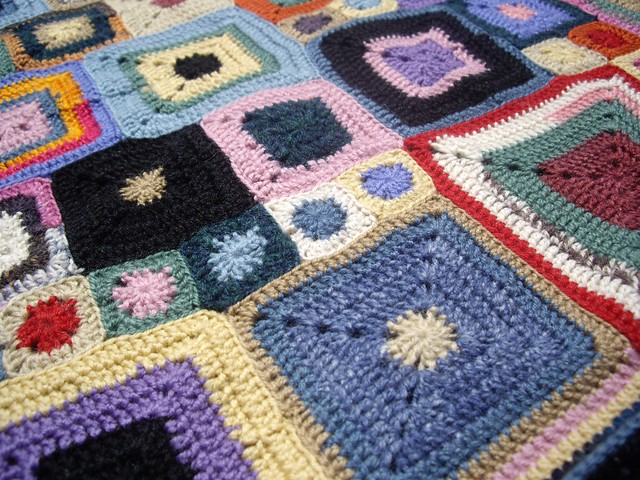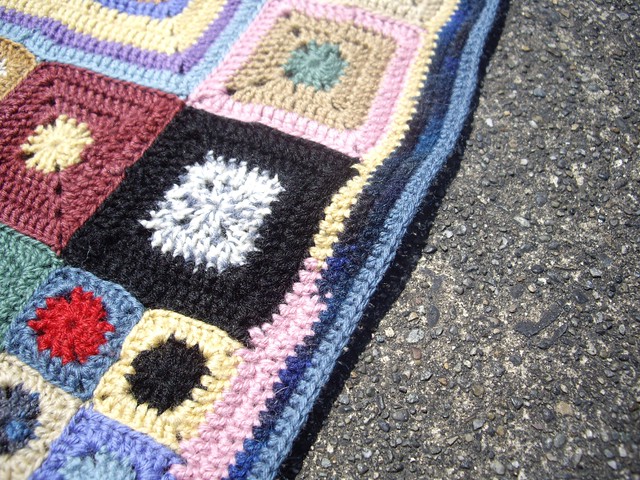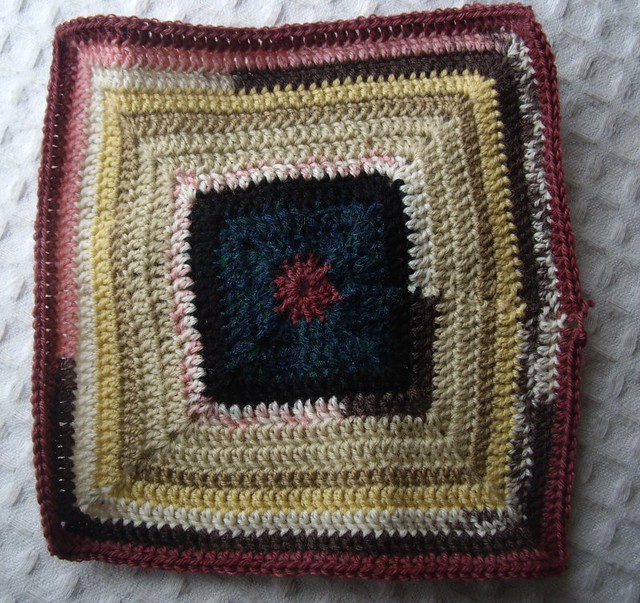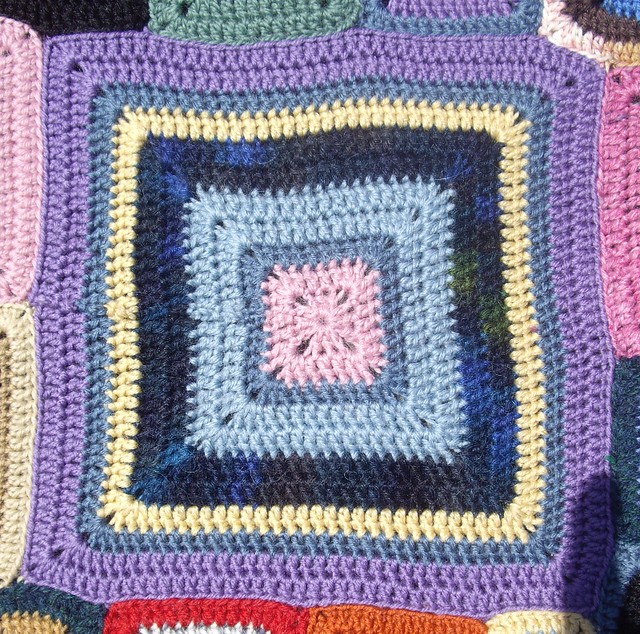Comments: Given how labour-intensive this project is, it amazes me that 762 people have crocheted their way through it before me (and that's just on ravelry) - truly a testament to its appeal.
To start with, yarn: the pattern calls for 17 different colours, and refers to them as yarns A through H, J through P, and R and S. And yarn substitution - yes, I did, as have many others. Out of the (currently) 1800 projects on Ravelry, only 250 have used a Koigu yarn (Premium Merino, the recommended yarn, or Painter's Palette Premium Merino). Seventeen skeins of the Koigu would set you back about US$230 so it's no surprise that people have used many other yarns. Crocheting completely from stash, mine was free.
On then to choosing what yarns to substitute in - I guess that if you are going to purchase yarn and can find a range with 17 different shades (and a good colour program, that is, the different colours go well together) that would take some of the guess work out of things. But if you are going to pull 17 yarns out of the cupboard (as I did), umm yes, there's a lot of guess work. I tried to get a grip on the overall colour scheme, I really did, by printing out and enlarging the blanket outline and buying 17 markers and colouring in the blocks. But no, it overwhelmed me. This was something that I only managed to get a grip on by doing.
What I learned: yarns A and B are contained in each of the 10- and 12-round blocks, and all but one of the 8-round blocks. And two rounds of A are recommended for the border. So if you are choosing your own colour scheme, these yarns are going to be prominent.
Unfortunately, not realising this, I designated self-striping yarns for A and B which I don't think are suitable for this project. They don't work too well in crochet and when used in the smaller blocks, the rounds are not long enough to accommodate the colour changes. Result for my blanket was that some blocks that contain the same self-striping yarn bear no resemblance to each other and there is little uniformity across blocks that contain that yarn. Also, my yarns, although all fingering weight, did differ in weight and texture, so that made my squares less regular.
Having said all of which, there was only one block, 12-1, that totally did not work and had to be re-crocheted (and of course, it was one of the largest). I didn't at all like the five to six rows that were all a similar pale shade, and didn't like the effect of the colour change in the self-striping yarn, from pale pink to dark brown suddenly. So I redid that one, utilising the inner part of one of the blocks that I accidentally duplicated (despite my best efforts to work methodically through the list of blocks, I still managed to crochet three of the blocks twice over. And completely missed two of the two-round blocks and had to fill them in after I had started seaming.) Again, I attempted to consider the whole blanket and the overall colour scheme and which colours were called for, and again I was totally overwhelmed and just grabbed the ones closest to hand. Worked out fine.
I also didn't follow the directions for the border - I chose two light colours, pink and yellow, and used these for the first round (and a little more, until they ran out actually). I swapped between the two in order to not be crocheting a pink border row across a block with an outermost pink row, and vice-versa for the yellow. Then I crocheted the rest of the second row and all of the third in a dark but bright yarn (Misti Alpaca Hand Paint Sock Yarn) and then a row of blue-grey.
For all that, the blanket only weighs 429 grams and I only managed to completely use up a few balls of yarn out of the 21 that I included.
This is a project that you really need to have a plan of attack for! I chose to crochet the squares yarn by yarn, that is, I started by crocheting every block that contained yarn A, followed by every block that contained yarn B and so on down the alphabet. For me this had the advantage that once I had finished all for the blocks containing yarn A, I could put it away and that was one less ball to carry around in my project bag.
 I didn't weave in the ends as I went, nor did I seam as I went so yes, I had a long end-weaving session and an even longer seaming session, followed by more end weaving, but that was ok for me. My initial reason for not seaming as I went was that I thought I might rearrange the squares a bit but as the blanket came together I was so overwhelmed by the overall schema that I dropped that notion very quickly. Stick with the schema!
I didn't weave in the ends as I went, nor did I seam as I went so yes, I had a long end-weaving session and an even longer seaming session, followed by more end weaving, but that was ok for me. My initial reason for not seaming as I went was that I thought I might rearrange the squares a bit but as the blanket came together I was so overwhelmed by the overall schema that I dropped that notion very quickly. Stick with the schema!And an observation, the pattern is actually laid out in a spiral, although I don't think that the current colour lay out highlights this. It might be interesting to repeat a colour as either the centre or outermost round that would trace a spiral through the sections. Just an idea.
There is also a gallery of each of my individual blocks, should you like to examine them more closely!
Verdict: It's wonderful, but I do wish that it were bigger. Would I do it again, in a heavier weight yarn? the question really is, could I do it again? I'm not sure.







No comments:
Post a Comment